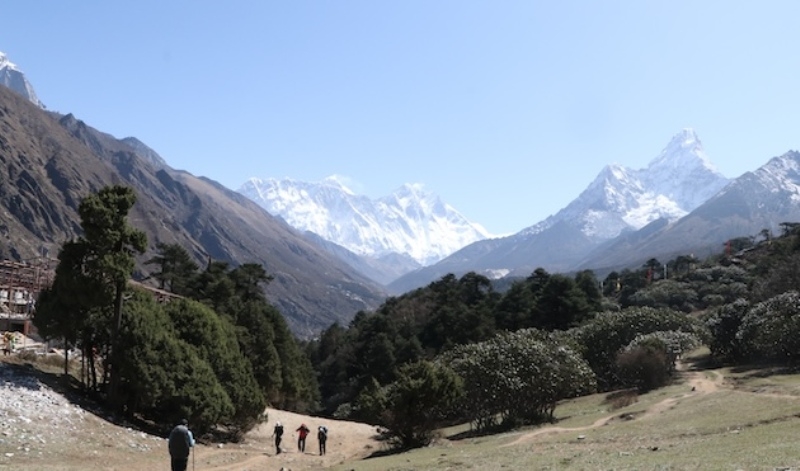- Tarique Rahman returns home amid rapturous reception |
- Home After 17 Years: Tarique Returns to Gulshan Residence |
- Tarique Calls for United Effort to Build a Safe Bangladesh |
- Tarique leaves for 300 feet area from airport |
- BNP top leaders welcome Tarique Rahman on homecoming |
How Much is Too Much for Mount Everest?
Is not it Time For Sagarmatha to Rest

Sagarmatha range from Thyangboche village en route to the base camp. Climbers and trekkers use this route. Credit- Tanka Dhakal-IPS
By Tanka Dhakal
KATHMANDU, Sep 16 2024 (IPS) - “That’s Mt. Everest!” I overheard this from a trekking guide to his trekkers team. I stopped and asked him—which one! He was not our guide, but I approached. He pointed a finger and showed me Mt. Everest and I cried—I don’t know why. I was overwhelmed and humbled to finally witness the world’s tallest mountain—it was not from the base camp but from Thyangboche while returning.
Whenever I think about mountains, I immediately go to that time when I was filled with emotions and the numbers of people going there. The Khumbu region, which is home to some of the world’s highest mountains, including Sagarmatha (Mt. Everest), is seeing an influx of climbers and trekkers, especially in the spring season, and concern is growing.
Last May, I had the chance to visit and report from the region. One thing I noticed was the concern about the increasing number of climbers and trekkers. I was stunned by the number of people returning and going towards the base camp—this made me think: Is it sustainable for the region, which is already vulnerable to the impact of rising temperatures?
In recent years, the number of climbers and trekkers has been consistently high, and the influx has led to incidents of “traffic jams” on Everest. Every year, more than 450 climbers from around the world get permits from the Nepal government to climb Mt. Everest, and this number is constantly growing. More than 50,000 people trek to the base camp every year, which I believe is too much for an ecologically and geographically vulnerable area like Khumbu.
There I met Kancha Sherpa, 92, the only living member of the 1953 first successful Mt. Everest expedition team. He voiced his fears, saying the mountain needs “rest” and “respect.”
“For the government, Mt. Everest is only about money,” Sherpa said. “And for climbers these days, it is only about creating records.” In his home in Namche, Solukhumbu, Sherpa shared his frustration over increased and largely commercialized mountaineering activities.
For sherpas, the mountain is their goddess, their home. They worship her. I remember Kancha Sherpa compassionately saying, “We are grateful. But our goddess is tired from human waste; she needs rest for some time.”
During my entire reporting trek and after returning, Kancha Sherpa’s voice was constantly echoing in my mind–the mountain needs rest and respect.
Yes, tourism and mountaineering activities are not only a way of livelihood for communities in Khumbu but also a major source of revenue for the government of Nepal. It is creating opportunities-even though locals are mainly forced to be a guide or helping hands to trekkers and climbers’ exploration.
But at what cost, or is it sustainable? I don’t believe it is. Science has been telling us for a long time now that the impact of rising temperatures is higher in the mountains. Reports are saying the impact of climate change in the mountains of the Hindu Kush Himalayan (HKH) region, which hosts the Sagarmatha range too, is unprecedented and largely irreversible. It means that changes to the glaciers, snow, and permafrost driven by global warming are extremely worrisome and need urgent action.
But the overflow of people in the Everest region is acting as a catalyst to the already vulnerable region and making it more prone to forthcoming worst situations.
Glaciers are retreating at a faster rate and creating glacial lakes, which may explode in the future and could sweep away everything in their path. The growing number of trekkers and climbers may be contributing to this disturbance of natural phenomena.
In the region, not only experienced climbers like Sherpa but also visitors are voicing their concerns—Dr. Alex Balauta was one of them.
Balauta, who traveled from Austria, said, “It was a secret place for so many years, but now it has become very commercial and crowded.” He expressed concern regarding the possible impact of overcrowding in the region and wished there would be appropriate intervention by the government to protect the sanctity of the Everest region.
I completely agree with his concern. To give rest to the fragile geography and keep it clean and secret, respecting local communities’ beliefs, there should be some kind of cap on the number of people allowed to climb and trek in the region every year.
And there is hope for people like us, which came as a mandamus order from court on April 26 (2024) the Supreme Court of Nepal said that the number of climbers and the climbing time should be permitted according to the mountain’s carrying capacity.
I strongly believe this verdict is historical and it opens the way to set a cap on the number of climbers in mountains, including Sagarmatha. The government needs to act promptly because it has already been late, and we all need to think critically, analyze, and decide on the urgent question: How much is too much for Mt. Everest?
I hope we all prioritize the needs of the mountains ahead of our quest to conquer them. And hope the government will listen to the decorated Sherpa’s loud voice: “Mountain needs rest!”
This opinion piece is published with the support of Open Society Foundations.
IPS UN Bureau Report

